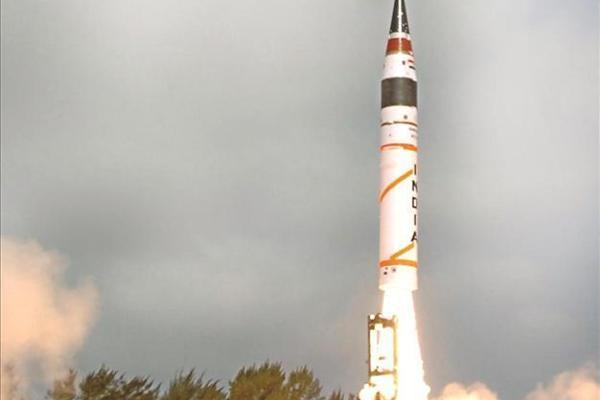Long-range missile club gets a new member: India
NEW DELHI


A surface-to-surface missile, called Agni-V, which means ‘fire’ in Sanskrit, is launched from the Wheeler Island off the eastern Indian state of Odisha. REUTERS photo
India has announced the successful test launch of a new nuclear-capable missile that can reach Beijing and Eastern Europe, a significant step forward in its aspirations to become a regional and world power.With a range of 5,000 kilometers, the Agni-V missile, which means “fire” in Sanskrit, still requires a number of tests and must clear other bureaucratic hurdles before it can be inducted into India’s arsenal. But officials yesterday hailed the launch as proof the country had taken its place among the world’s most powerful and scientifically advanced nations. The Agni-V is the crowning achievement of a program developed primarily with the threat posed by neighboring China in mind. It will not be operational for at least two years, the government said.
Up to now only the permanent members of the U.N. Security Council – China, France, Russia the United States and Britain – as well as Israel, are believed to have such long-range weapons. Indian Prime Minister Manmohan Singh hailed the launch as “another milestone in our quest to add to the credibility of our security and preparedness and to continuously explore the frontiers of science.”
The test came just days after North Korea’s failed rocket launch, but sparked none of the same global condemnation aimed at Pyongyang, an internationally isolated regime that has been banned by the U.N. from testing missile technology. China is far ahead of India in the missile race, with intercontinental ballistic missiles capable of reaching anywhere in India. Currently, the longest-range Indian missile, the Agni-III, has a range of 3,500 kilometers and falls short of many major Chinese cities.
Video released by the government showed the Agni-V taking off from a small launcher on what appeared to be railroad tracks at 8:07 a.m. from Wheeler Island, off India’s eastern coast. The missile hit an altitude of more than 600 kilometers, its three stages worked properly and its payload was deployed as planned, the head of India’s Defense Research and Development Organization, Vijay Saraswat, told the Times Now news channel.
State-owned China Central Television called the test “a historic moment for India and it shows that India has joined the club of the countries that own ballistic missiles. … China and India are both big emerging countries. We are not rivals but cooperation partners,” Chinese Foreign Ministry spokesman Liu Weimin said.
The Agni-V is a solid-fuel, three-stage missile designed to carry a 1.5-ton nuclear warhead. It stands 17.5 meters tall and was built almost completely with Indian-made technology at a reported cost of $486 million. India already has the capability of hitting anywhere inside neighboring Pakistan, but has engaged in a splurge of defense spending in recent years to counter the perceived Chinese threat. The Indian Navy took command of a Russian nuclear submarine earlier this year, and India is expected to take delivery of a retrofitted Soviet-built aircraft carrier soon.
